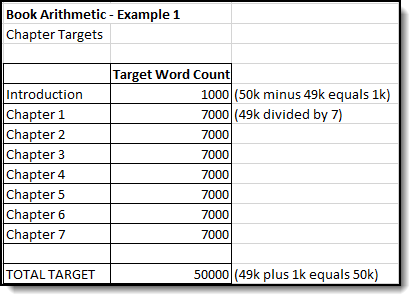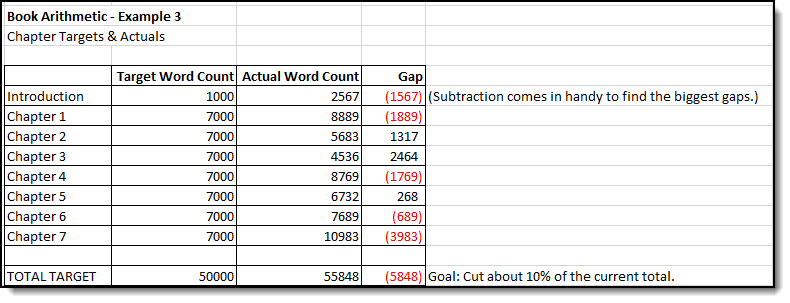
The more I work with books, the more I realize how helpful arithmetic is (yup, just arithmetic—no algebra, geometry, or calculus needed). Whether you have too little content, too much content, or lopsided content, some addition, subtraction, and division (not finding a use for multiplication yet!) can help set guideposts to keep you on track, identify areas for potential revision, and create a better reading experience for your audience.
Let’s look at four ways arithmetic can help you write.
Setting Clear Goals
The most common way people find my website is searching for “how long should my book be?” Of course, the philosophical answer is “as long as it needs to be and no longer,” but that’s not very useful in a practical sense. While readers might think about books in terms of page count, authors and publishers usually think about word count. (The two are of course correlated, but for any given word count the number of pages can vary widely depending on formatting choices.)
If you have a publishing contract, you may be obligated to meet a specific word count, say a minimum of 55k or a maximum of 75k words. If you are publishing independently, you get to choose how long your book is based on your audience analysis, genre conventions, and so on. When in doubt, my advice is to begin by targeting 50k words—a solid but not overwhelming length for both author and reader.
With your total wordcount target in mind, create a spreadsheet that lists your chapters and their respective word count targets. If you’ve got seven chapters in your 50k-word book, that’s roughly 7k words per chapter (49k divided by 7), plus an extra thousand for an introduction. (See how that adds up?)

While working on your draft, you can break down your goals even further within each chapter. If you know each chapter has an opening story, three main points, and a concluding section, you can break the chapter into five equal sections of 1400 words.
Or, you can be more strategic and allot 500 words each for the open and close and 2k words for each of the three major points. Then, if you know you have three subpoints for each major point, you’ve got about 670 words for each section.

Do you see how having a daily target of writing one section that is 670 words feels more doable than a generic goal of writing 1000 words? (It certainly feels easier than “write a 50k-word book.”) Not only is it a manageable amount of writing (for context, this article is about a thousand words), the content is “chunked” so your brain can stay focused on one topic at a time.
Learning to Take Up Space
If you write short pieces such as blog posts or newsletter articles on a regular basis, you may be used to writing concisely—trimming any extra words so that you don’t lose online readers. But books are a different art form. Readers expect more expansiveness and explanation on your topic. It can be disorienting to shift to more expansive writing without some sort of guideline, so use your word count spreadsheet to keep in mind how much space you need to (or rather, you get to) take up.
When a topic that might warrant 500 words in a blog post now has 1500 words allocated to it in your book, you may have to shift mindsets to explore what your reader will find useful and compelling in this new context. Don’t be afraid to experiment and even write what might be “fluff.” It may take time and iteration to find the right angle.
That said, if you are consistently coming in under your numerical goals, it may well be that you’ve said what you need to say and a short book is the right form. For example, Steven Pressfield’s The War of Art, a book many creatives love, comes in at about 25k words in many short chapters. Go back to your purpose, strategy and brand promise to test whether a short book is a sound approach for you.
Cutting Content
For any number of reasons, you may have a maximum word count. It may be set in your publishing contract, you may have budget constraints in self-publishing, or you may know your audience won’t read beyond a certain point. But draft manuscripts are often too long, so you may need to cut. Do it strategically.
Go back to your spreadsheet (or create one) and map out how your total word count breaks down by chapter. Use a little basic subtraction to find the gap between target and actuals. (Oh, this is starting to feel like budgeting, isn’t it?)

As you revise, keep a running tally so you know where you are and how much more you need to tighten to reach your target. On a related note, look especially at the largest gaps to determine if the chapters are out of balance—our final arithmetic tip.
Balancing Content
Even if you don’t need to cut content, it can be a useful exercise to check your word count across chapters to see if they are evenly balanced. The idea is not to be rigid in your chapter length, but rather to create a consistent experience for readers. Consistency lets them know what to expect, which increases their comfort level so they can focus on the content itself.
If you know each chapter should be roughly 5k words, when you see a chapter of 2k or 10k, consider it a yellow flag. Having only 2k words may indicate you need to add content or that the content can be combined with another chapter. If your chapter is 10k words, you might need to tighten it significantly or split it into two chapters.
Again, your book may work splendidly with varying chapter lengths, but doing the arithmetic lets you make such deviation an intentional choice.
Get out your spreadsheet!
Whether you’re just starting your book or nearing the end, adding some number-crunching to your wordsmithing can bring the clarity and structure needed to keep you on track.
Not sure if your manuscript is the right length? A manuscript critique and strategy intensive might help you see where to add, subtract, and rearrange. Get in touch at karin@clearsightbooks.com or 919.609.2817.

